
Originally published by Vera Files on April 22, 2020.
Nutribun. Kadiwa. Research Institute for Tropical Medicine. These are “brands” associated with the ousted dictatorship of Ferdinand Marcos that the COVID-19 crisis has brought to the forefront again.
On March 19, 2020 San Miguel Corporation announced it will start producing nutribun “for the hardest-hit families facing hunger as a result of the COVID-19 crisis.” The Department of Agriculture secured PHP 1 billion from the Inter-Agency Task Force for the Management of Emerging Infectious Diseases for the upscaling of its Kadiwa program. And Senator Imee Marcos reminded us that it was her dictator-father who built RITM, where almost all testing was done in the first weeks of the coronavirus outbreak in the country.
This is not to disparage these efforts and institutions, especially in this time of crisis. But as with all things Marcos, when history is brought to bear on nutribun, Kadiwa, and RITM, we are bound to learn of their flawed, if not failed execution during the dictatorship. This is what the current propaganda effort erases.
NUTRIBUN
It was also during a time of crisis that the Marcoses tried to make nutribun their own. Fifty years later, Imelda’s daughter, now Senator Imee Marcos continues to tout this piece of bread as Marcos manna.
On July 12, 1972, then President Ferdinand Marcos placed the entire island of Luzon under “a state of public calamity.” He immediately ordered a price freeze in response to the intense flooding that Typhoon Gloring (international name Rita) unleashed in the country from July 10–25, 1972. Up to 543 people were killed according to a report by the United Press International (UPI).
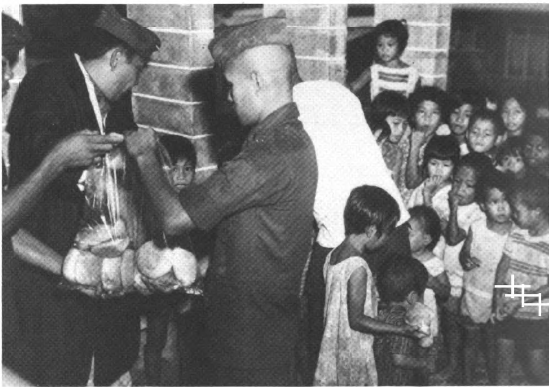
Nutribun as part of the relief efforts in the early 1970s. From the AID publication War on Hunger, October 1972.
It was during this period of calamity that Imelda made her move to turn foreign assistance into a branded Marcos largesse. A 2017 report in the newslab.philstar.com quoted Nancy Dammann’s memoir, My 17 Years With USAID, on what exactly Imelda did: “the nutribun bags were being stamped with the slogan ‘Courtesy of Imelda Marcos–Tulungan project’.” Lee Lescaze in an August 4, 1972 syndicated column, made a similar observation. “Plastic bags stamped with her name were being widely used at one time for relief grain distributed in central Luzon’s most-damaged villages.”
From these days of disaster, the one product that borrowed deep in the collective memory was nutribun. Not only was it present in relief packages during disasters since 1970, it was a staple in the AID’s fight against hunger and malnutrition in the Philippines.
AID described the bread as a “complete ready-to-eat meal” with more than 500 calories and over half an ounce of protein each. Major ingredients are wheat flour, nonfat dry milk and vegetable oil supplied under the Food for Peace program, combined with lesser amounts of sugar, salt and yeast. All principal nutrients, except VitaminC, are furnished in each bun.
Discussing the origin of nutribun, Paul E. Johnson, wrote in the July 1973 issue of War on Hunger that “the testing and development of soy fortified bread flour was undertaken primarily by Dr. C.C.Tsen and Dr. William J. Hoover of the Food and Feed Grain Institute of Kansas State University. Working under an AID contract, begun in 1967, to improve the nutritive value of cereal-based foods.” Their objective was to develop a bread “with 12 percent soy flour [that] is virtually indistinguishable from white flour bread–in texture, color, taste, loaf volume, or other traits. It is high in total protein, has well balanced protein, and it is relatively inexpensive to produce.”
The nutribun was first introduced in the Philippines in 1970. Mainly as part of relief efforts. The nutribuns that reached the schools as part of a nutrition program, were developed by Albert S. Fraleigh, an AID Food for Peace officer, and Dr. Ruben W. Engel, an AID contract officer and professor at the Virginia Polytechnic Institute, who worked together in the field of child nutrition and the fostering of school and pre-school child-feeding programs.
In 1971, as reported by AID in the December 1977 issue of War on Hunger, the Philippine government launched a four-year Philippine Food and Nutrition Program.
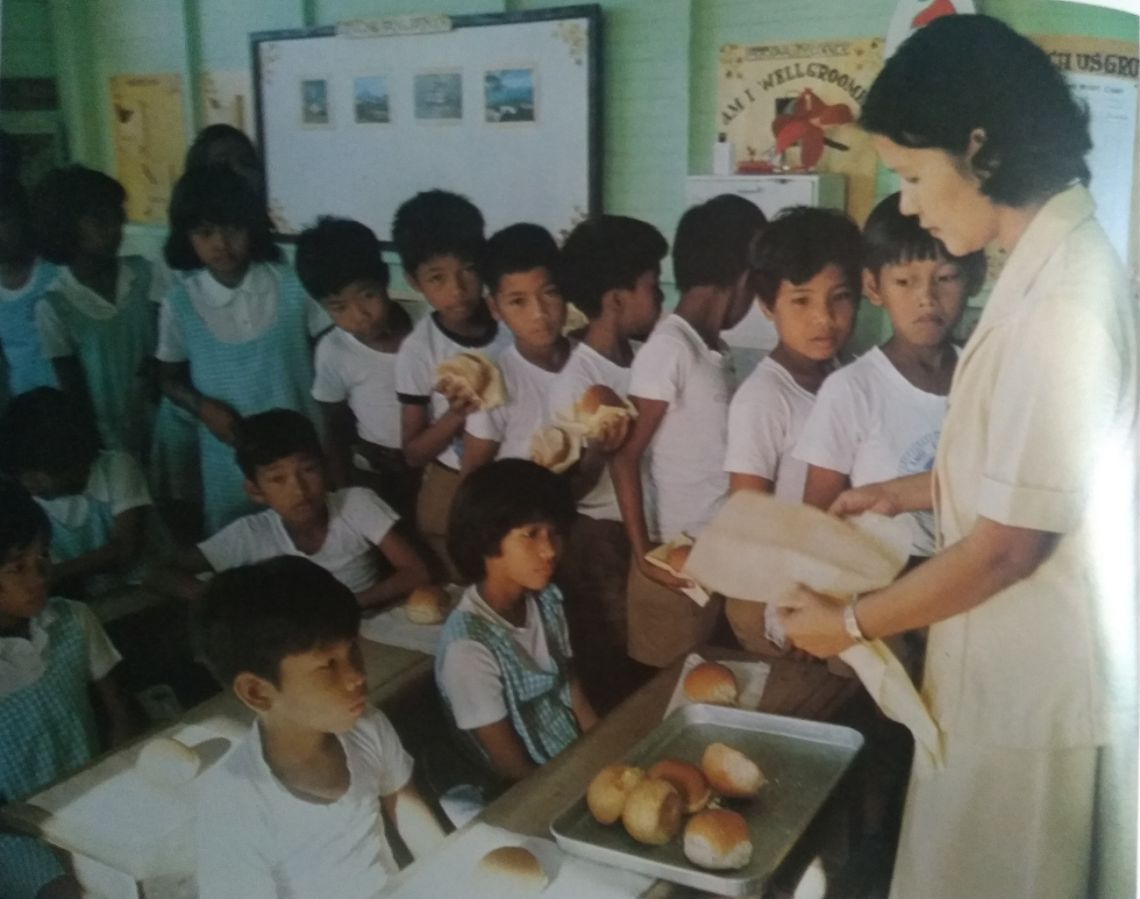
Nutribun as part of the feeding program in public elementary schools. From The Marcos Revolution: A Progress Report on the New Society of the Philippines, 1980.
A central part of the government’s nutrition scheme was the school feeding program whose target was to reach 2.7 million underweight or malnourished children, particularly in public elementary schools.
But that goal seems to have been ambitious. AID reports from 1971 to 1982 (the last year when there was a formal assessment of the program) showed the top number reached was in 1973 with 1.7 million recipients. In 1982, recipients stalled at 1.25 million. From 1970 until the Marcoses were ousted in 1986, the number of public elementary school students rose from 6.9 to 8.8 million.
Also, the nutribun was not given free. At the start, an elementary school pupil paid PHP 0.10 for each nutribun; by the mid-1980s, PHP 0.25. The very poor students were provided sponsors.
It was not only the price of nutribun that changed over the years. From 500 calories, content was eventually halved to 250 calories (the same caloric count as today’s SMC nutribun).
There were also doubts on its impact in curbing malnutrition. Barry M. Popkin and Marisol Lim-Ybanez wrote in the journal Social Science and Medicine in 1982: “There is little evidence . . . that present school feeding programs have significantly enhanced the physiological capacity of students.” The 1982 national survey on nutrition also showed 40 percent of some four million households in the bottom half of the economic scale, or 1.6 million households, experienced hunger almost daily.
More than three decades later, on October 8, 2018, the siblings Bongbong and Imee Marcos started circulating in their various social media platforms a short video clip titled “Edukasyon at Palakasan” (Education and Sports) ostensibly to celebrate the 101st birth anniversary of Ferdinand Marcos. It made a straightforward claim: that nutribun solved the problem of malnutrition in schools.
KADIWA
On March 29, 2020, Senator Imee Marcos posted about Kadiwa on her Facebook page. The text was largely lifted from the history of the Food Terminal, Inc (FTI). The short history of FTI correctly attributed the emergence of Kadiwa stores to the oil crisis of 1973, when prices of many commodities soared and scarcity of food was felt. “It was during this time that the concept of retailing the seven basic commodities at government-controlled rates was systematized. On April 14, 1980, the first KADIWA Center was put up at the FTI Complex,” it said.
But even before the first Kadiwa store was put up, another oil price shock rippled through the country in 1979. Transport, water and power rates rose and commodity prices spiked.
Jürgen Rüland, in a 1986 article in the Asian Journal of Public Administration, pointed to a pre-Kadiwa effort of the Imelda Marcos-led Metropolitan Manila Commission (MMC) – the so-called “rolling stores” project in 1979 that sold food and essential items in depressed areas at subsidized prices.
The actual legal basis for the Kadiwa stores was the 1981 Presidential Decree (PD) 1770 which placed FTI, and with it the incipient Kadiwa, under the National Food Authority (NFA). PD 1770 also designated Imelda as the head of the council that ran the NFA.
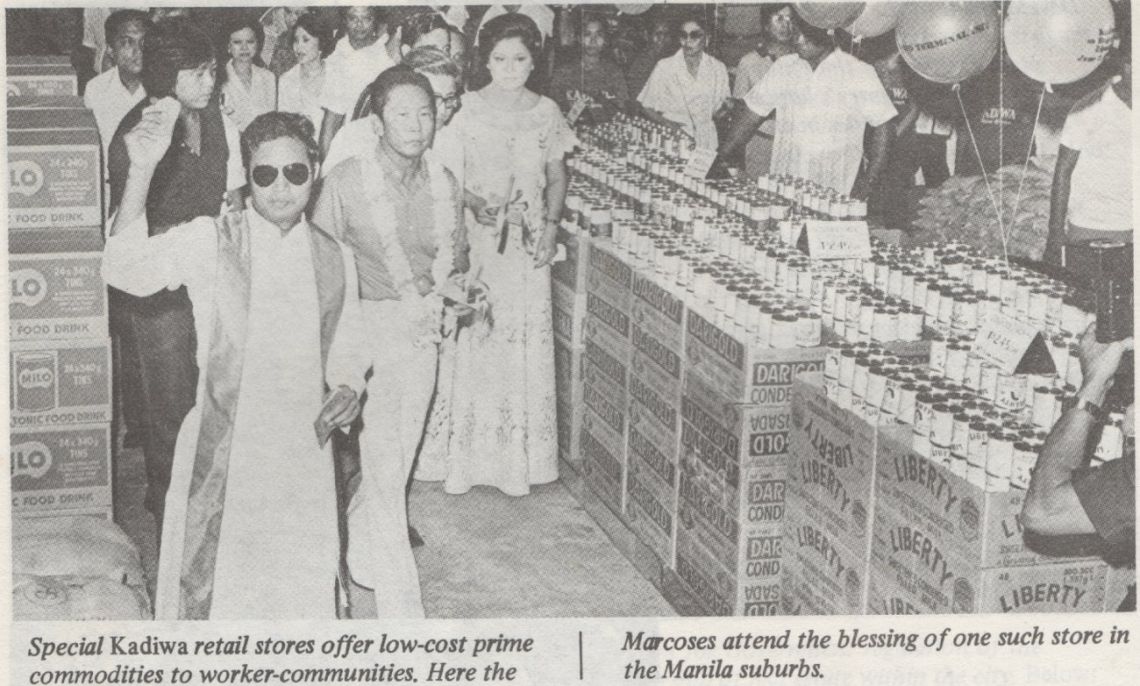
Inauguration of a Kadiwa store with Ferdinand and Imelda Marcos in attendance. From The New Philippine Republic, 1982.
Ramon L. Clarete, in the 2008 book From Parastatals to Private Trade: Lessons from Asian Agriculture, described how NFA responded to this particular mandate by launching the Kadiwa program, operating mobile and retail stores in urban and depressed areas. The stores sold at subsidized prices basic food items like rice, sugar, cooking oil, coffee, milk, and noodles.
Imelda proved to be the controlling presence behind Kadiwa. As minister of human settlements and head of the MMC, she also led the NFA.
But the public money that went into subsidizing Kadiwa was not just for the commodities it sold. Gerardo P. Sicat, Marcos’ former minister of Economic Planning, explained in a December 1984 speech that to set up and support Kadiwa stores, the NFA, through FTI, had to invest in new buildings, transport equipment as well as raise its working capital to hold inventory and hire addition manpower.
Even during its heyday, reception to Kadiwa by Manila’s poor was not as enthusiastic as now recalled. A perception study on poverty and programs to redress it among Manila’s poor published by Leandro A. Viloria and Dolores A. Endriga in the October 1984 issue of Philippine Planning Journal found that people were discouraged by the queues, the distance of the stores and some irritable service personnel.
By 1983, in the face of ballooning foreign debt obligations, another peso devaluation, and a drought, the promise of cheap prime commodities from Kadiwa became as scant as the goods on its shelves. In June and July of that year, there was a sugar and rice shortage, and the price of cooking oil spiked. All these were before the economic and political tailspin that the assassination of Ninoy Aquino triggered in August that year.
Hoarding and overpricing became common. Raids on stores and warehouses became a news staple. By May 1984, the scarcity of consumer goods accompanied by rising prices, remained an unsolved problem for Marcos. The best he could do was to impose price control on basic commodities.
By November 1984, a kilo of rice cost PHP 5.35 in Kadiwa outlets; it was PHP 4.25 in May. The average minimum daily wage dipped from PHP 20.00 in 1983 to PHP 16.00.
On May 31, 1985 Marcos issued Executive Order (EO) 1028 instructing the NFA to transfer “all Kadiwa and other non-grain operations of the [NFA] to [FTI], and subsequently (b) the transfer or divestment of the operations of [FTI], including the Kadiwa operations, as a joint venture between the government and the private sector, without prejudice to the possibility of a full transfer to the private sector immediately or ultimately.”
Clarete argued that Marcos’s epiphany was more of buckling to pressure from the Asian Development Bank. “In 1985, in need of foreign exchange to manage its foreign debt, the government agreed . . . to end both the Kadiwa program and the wheat import monopoly of NFA. Political support for the program weakened as the Marcos government became increasingly isolated.”
For Sicat, it was a costly and losing operation from the start. And in the end, he said, Kadiwa lost to “the small sari-sari neighborhood store and the medium-sized grocery.” Viloria and Endriga’s study supported Sicat’s conclusion. Instead of going to Kadiwa, respondents went to nearby markets, spending less on transportation, it said.
Rüland also expressed skepticism that Kadiwa actually helped the poor. He pointed out that by government’s own claim, it spent within two years 18 million pesos for the rolling stores and the Kadiwa project, reaching some 247,000 families in 542 depressed and semi-depressed areas. “In actual fact, this means that the government spent 24,658 pesos per day for these prime commodities or 0.10 peso per family per day. It goes without saying that given these allocations the project’s effect on the living conditions of the poor was virtually nil.”
Kadiwa’s failure despite being backed by four government agencies—the MMC, the FTI, the MHS, and the NFA, all ruled by Imelda—points only to the bureaucratic drag that sunk it and the broader economic and political malaise then afflicting the nation.
THE RESEARCH INSTITUTE FOR TROPICAL MEDICINE
With RITM continuously in the news due to COVID-19, Imee Marcos’s Facebook page
showcased the medical facility on March 14, 2020. The text of the post was largely lifted from the Wikipedia entry on RITM, which cites Ricardo Manapat’s Some are Smarter than Others: The History of Marcos’s Crony Capitalism as a source. Imee’s page was careful, however, not to include criticism of RITM from Manapat’s book, which discusses the intricate web of Marcos plunder as it was understood back in 1991.
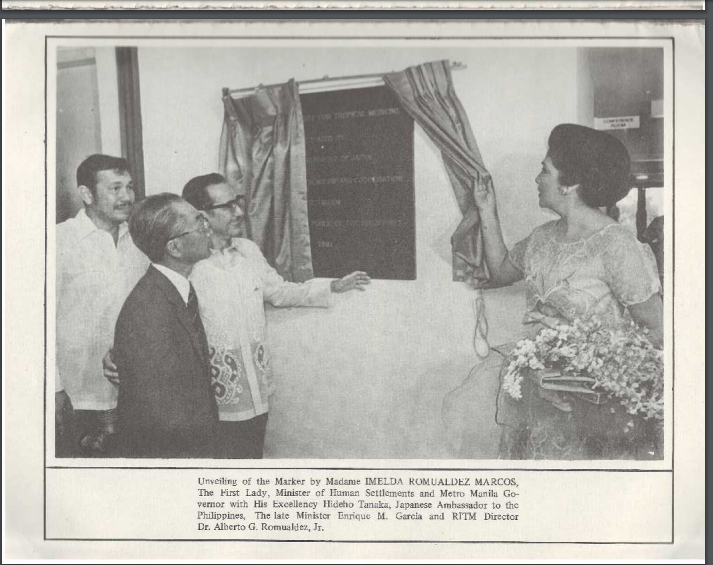
Imelda Marcos unveiling the RITM marker. From the RITM Annual Report, 1981.
Manapat described RITM as “[one] of the relatively unknown projects of Imelda Marcos.” He highlighted how it was organized in cooperation with the Japanese government and funded by the Japan International Cooperation Agency. He said Executive Order No. 674, dated 25 March 1981, defined it “as an institute for the development of basic and applied research [programs] for tropical medicine in the Philippines.” After such factual declarations, Manapat then casts doubt on the value of RITM during the Marcos regime:
[The] impression created by the RITM is that it was organized to benefit Japanese research rather than Philippine health. Of the 1030 admissions in the hospital, 815 or 79.1% were treated as research patients. It claimed that the institute’s research program was supervised by the Ministry of Health, but results of the five years of studies made by local scientists were never published. Instead, the research was merely turned over to the Japanese in return for aid grants. It is not certain that the indigent patients of this institution were ever informed that they were not receiving standard and tested treatment but were being subjected to experiments commissioned by the Japanese.
Most of Manapat’s claims can be checked against various sources. It is difficult to prove the Japanese did benefit more from RITM than Filipinos. However, based on a 1985 JICA report, the original name of the proposed institute was the Philippine Japan Research Institute for Tropical Diseases. This initial proposal made clear it was a joint Philippine-Japanese effort, with the proposed institute having a Japanese co-chairman.
The Technical Cooperation Agreement between the Philippines and Japan for the RITM project entailed an exchange of scientists. According the institute’s 1985 annual report, by that year, 15 Filipino scientists had been posted in various research centers in Japan for training, while 16 Japanese scientists had been sent to RITM as consultants.
The admissions figures cited by Manapat are from RITM’s 1985 annual report, which covers January 1 to December 31, 1985. RITM’s earlier annual reports did not indicate such data. In any case, that majority of admitted patients became research subjects should not be seen as unusual, given RITM’s mandate.
On the publication of research findings, annual reports of RITM from 1981 to 1985 show a lot of the outputs by the institute’s researchers were published in academic and professional journals and presented in conferences even if they were not popularized.
Finally, it seems likely, given the global standards of medical research ethics at the time that patients who participated in RITM research studies did so with their consent. From 1981 to 1985, RITM had Institutional Review and Ethical Review boards.
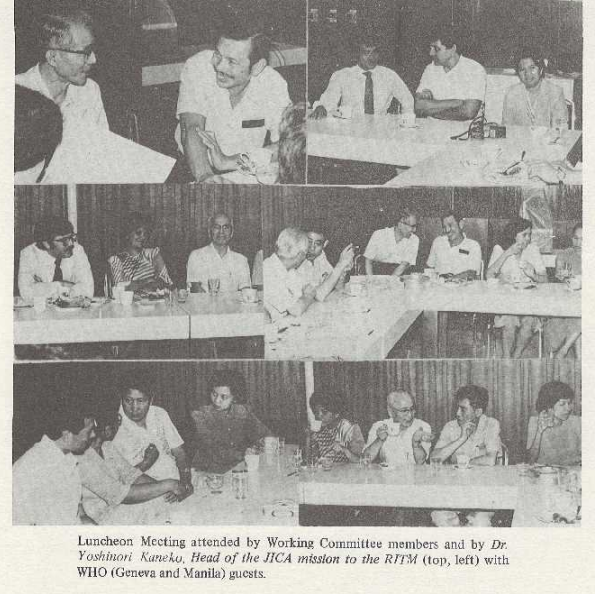
JICA officials at the RITM. From the RITM Annual Report, 1981.
Indeed, what Imee Marcos and Marcos supporters have failed to emphasize is how dependent RITM was on the Japanese government’s funding. Financial statements in the RITM’s annual reports from 1981 to 1985, showed hardly any capital or equipment outlay from the national government. Its allocation during that period, averaging about PHP 7 million annually, was mostly for personnel services and operating expenses.
RITM’s 1984 annual report indicated JICA had provided USD 1 million (about PHP 18 million) to the institute since 1981. In 1985, the year RITM’s experimental animal laboratory was inaugurated, JICA provided another PHP 3.2 million worth of equipment
Clearly, RITM thrived because of external support and excellent researchers. Without foreign funding, it seems unlikely that RITM would have become a performing asset.
Moreover, the country’s current crisis emphasizes the fact that RITM and other government hospitals with advanced capabilities are in Metro Manila.
Even Imee Marcos acknowledged the issue of Manila centralization when she filed Senate Bill No. 1407 in response to the COVID-19 pandemic, which sought to establish RITMs in regions outside the capital. The explanatory note in her bill mentions Ferdinand Marcos’ executive order establishing RITM, but nothing about Japan’s primary role in designing, building, and supporting it for eight years.
The Filipinos who remember with fondness nutribun and Kadiwa, or to have availed of RITM’s services were the very same ones whose lives were reduced to penury by the kleptocratic Marcos regime. Whatever small measure of service they have received from the conjugal dictatorship, they have treasured it as one of those rare instances then when the government appeared in their midst — like the perfumed and bejeweled Imelda sauntering in the slums of Tondo. Such uncritical sentimentalism is the fertile ground for the subsequent Marcos propaganda.